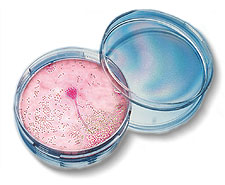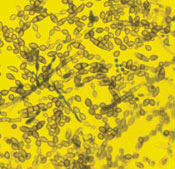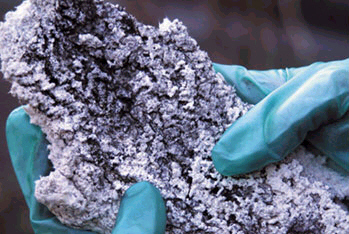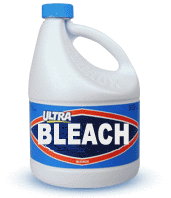 What's
all the fuss? If you watch the news or read the newspaper, you have probably
seen articles dealing with mold and/or toxic mold. Mold issues are nothing
new as mold has been around for centuries. What is new are the problems
and health related affects associated mold that have garnered the public's
attention. Mold jumped back into the public's eye in 1998 when a
Texas court awarded the Ballard family $32 million dollars in their case
against Farmer's Insurance group for mishandling their claim for
mold damage to their home. Since then there have been numerous property
damage claims in states all across the nation. In addition to property
damage claims, claims seeking reimbursement for costs associated with
the health effects of mold are also on the rise.
What's
all the fuss? If you watch the news or read the newspaper, you have probably
seen articles dealing with mold and/or toxic mold. Mold issues are nothing
new as mold has been around for centuries. What is new are the problems
and health related affects associated mold that have garnered the public's
attention. Mold jumped back into the public's eye in 1998 when a
Texas court awarded the Ballard family $32 million dollars in their case
against Farmer's Insurance group for mishandling their claim for
mold damage to their home. Since then there have been numerous property
damage claims in states all across the nation. In addition to property
damage claims, claims seeking reimbursement for costs associated with
the health effects of mold are also on the rise.
What's all this have to do with you? Whether or not you have a home infected with mold or have health effects related to mold, you are impacted by all of these mold-related problems. To combat the rising number of claims, insurance companies are increasing home owner's and health insurance premiums. Some insurance companies are now instituting riders putting a cap on the amount of damages that can be recovered in the event of a mold infestation.
 Mold
and mildew are types of fungi. Fungi are organisms with rigid cell walls
but contain no chlorophyll. Chlorophyll is the molecule essential to photosynthesis:
the process that takes energy from the sun and converts it into food.
Since fungi lack chlorophyll, they must find their food sources elsewhere.
Water and a source of organic nutrition provide the food fungi need to
survive.
Mold
and mildew are types of fungi. Fungi are organisms with rigid cell walls
but contain no chlorophyll. Chlorophyll is the molecule essential to photosynthesis:
the process that takes energy from the sun and converts it into food.
Since fungi lack chlorophyll, they must find their food sources elsewhere.
Water and a source of organic nutrition provide the food fungi need to
survive.
Mold will grow indoors if there is sufficient moisture. Sufficient moisture is generally a relative humidity of at least 60%. Moisture from an intrusion such as a flood or leaking roof or water pipe will also be a sufficient source for mold to grow and thrive. Many common building materials such as wallboard, carpet, ceiling tiles, and wood consist of cellulose materials that are particularly suitable for mold growth when they are wet.
It's also important to understand how molds reproduce in order to understand how they may affect your health. Molds produce tiny spores of about 1 micron in size. Just how small is this? About 250,000 mold spores could fit on the head of a pin. These spores are released into the air and alight on surfaces within the home. If the needed moisture and food are present where the spores land, then mold will begin to grow.
There are an estimated 100,000 plus species of mold with 1,000 or more species commonly found in the U.S. In general, molds are an important part of the nutrient cycle because they break down dead materials in soil, food, plant materials, and other organic matter making it available for plants and other organisms.
Common Types of Indoor Mold
Some molds have beneficial commercial uses and are used to create cheese and drugs such as Penicillin and Cyclosporine (an immune suppressant used in organ transplants). According to the CDC, all molds have the potential to cause health effects.
Toxic molds are molds that emit or contain mycotoxins. Mycotoxins are chemicals that can be toxic to humans and animals. They are found in the mold spores, within the mold itself and in the materials where the mold is growing. Approximately 15-20 types of mold are known to produce mycotoxins.
Stachybotrys chartarum, which you may also see referred to as just Stachybotrys, is the most well-known or notorious toxic mold. It is also referred to as "Black Mold" due to its color being black or very dark. Black or dark coloring is common for many molds, therefore, just because you find black mold in your home doesn't mean that it's Stachybotrys. Also, Stachybotrys does not grow on plastic, vinyl, concrete products, or ceramic tiles and is not found in the green mold on bread.
Mold and toxic mold share many of the same effects. Your reaction to mold exposure is directly related to your sensitivity to mold. The more sensitive or allergic you are to mold, the more severe your reaction when exposed. Reactions to mold can be instantaneous, occurring after a single exposure (acute) or occur only after repeated, long-term exposure (chronic)
The most common effect from mold is an allergic reaction. People with mold allergies or sensitivity to mold may experience typical allergy-like symptoms including: nasal stuffiness, runny nose, watery eyes, eye irritation, sneezing, wheezing, itching, dizziness, skin irritation, and fatigue.
People with serious mold allergies, approximately 10% of the population, or those who are exposed to large, concentrated doses of mold, such as directly handling a moldy material, can have severe reactions that may include fever, shortness of breath, or more severe cases of any of the common allergy symptoms.
In addition to all the common allergy-like symptoms noted, toxic molds are claimed to have caused pulmonary hemorrhage, memory loss, extreme lethargy, suppression of the immune system, and cancer. There is no study that has proven a causal link between toxic mold and these associated health effects. The US EPA, Centers for Disease Control (CDC), and various state environmental/health departments, and scientists continue to study the problem and searching for a definitive link. Since mycotoxins may present greater hazards than that of common molds, you should minimize your exposure whenever possible.
One fact that all health agencies and scientists do agree on is the fact that prolonged exposure to mold is not healthy. If mold is present in your home you should take measures to eliminate it as soon as possible. If you have any persistent symptoms you should see your doctor for diagnosis and treatment.
The most common routes of exposure to mold are through inhalation, ingestion, and direct contact. Mold spores enter your respiratory system by breathing in the mold spores that are in the air. Direct contact with mold may cause immediate skin irritation or you might accidentally transport mold spores from your hand to your food or mouth causing you to ingest the spores. Almost all the information related to diseases caused by mycotoxins (toxic mold) concern eating contaminated food. Ingesting moldy foodstuffs could cause both immediate and long-lasting damage to the liver, kidneys, gastrointestinal tract, heart, central nervous system, and the immune system.
Infants and children, elderly persons, people with allergies and asthma, and people with suppressed immune systems (HIV, chemotherapy, organ transplants) are most affected by mold exposure.
The most obvious way to tell if you have mold in your home is to see it.
However, problem causing mold may not always grow in places that are easy
to see so you may need to use other clues to alert you to the fact that
you need to look for the mold. Clues indicating you may have mold growth
are:
· the presence of an earthy or musty smell
· signs of excessive moisture in the home
· worsening of any allergy-like symptoms.
Molds may be cottony, velvety, granular, or leathery in appearance and have be white, gray, brown, black, yellow or green in color. Visible mold will often appear as a discoloration, staining (speckled), or fuzzy growth on the surface of building materials (such as baseboard trim or drywall) or furnishings.
If you do notice an odor in your home, follow the odor to the area where you believe the odor is strongest. Perform a thorough search of the area. First, look for any sign of excess moisture or water damage including water leaks, standing water, water stains, or condensation on walls or windows. Moisture is a key requirement for mold growth. Be sure to check areas above eye level including ceilings and windows.
If no sign of moisture or water damage is present, search behind and underneath carpet and pads, wallpaper, vinyl flooring, sink cabinets, furniture, stored boxes especially if they are near an outside wall or on a cold floor. If you don't find mold in any of these places then it may be located in the spaces behind the walls, under floors and in ceilings especially if any of these areas have ever suffered water damage. To find out if you have mold in these types of spaces, you will need to tear out a portion in order to investigate. This can be expensive and you before going to these extremes you may want to get some professional help or advice to help you devise a plan to cause a minimum of damage to your home while searching for the mold.
An alternative that bears mention in the search for mold in your home is that there are several companies throughout the US who are using dogs to pinpoint mold in homes. While using dogs to find mold in homes is a new concept in the US, they have been used in Europe for this purpose for many years. The dogs are trained and certified to detect and pinpoint at least eighteen different kinds of the most common toxic molds. Since dogs have a very sensitive sense of smell, they can detect mold odors at concentrations undetectable by humans. Some companies claim that the dogs are 90% effective in finding the source of mold in a home which can save considerable costs in remediation if the source of mold is not visible.
Most government and health related agencies agree that you should NOT test for mold as an initial step. Testing for mold contamination is generally not recommend as there are few available standards for judging what is an acceptable quantity of mold. There are no standards set by the EPA, CDC, and other federal or state agencies that specify what is a "safe" mold level. This means if you do have the testing performed and mold is detected, you have no idea if the level of mold found in your home is acceptable or unacceptable.
In lieu of testing, your first step should be visual inspection following the procedures outlined in "How do I know if I have mold in my home?" above. If you see mold or smell mold odors, you should assume you have a problem.
If you are convinced that you still want or need testing performed, there are two reasons why you might want to test for mold. One reason is to see what levels of mold are in the air inside your home. The other reason is to identify the type of mold you have present. All analytical laboratory testing can be quite expensive and require the use of an analytical laboratory to conduct the analyses.
To determine the level of mold in the air in your home, you will need to contract an environmental professional to collect the air samples. There is always some level of airborne mold present outdoors. Therefore, it is necessary to collect an outdoor sample at the same time you collect an indoor sample to provide a comparison. The outdoor sample provides a baseline measurement for the amount of mold that is normal for your area. A mold spore count of your indoor air without the corresponding outdoor mold spore count is meaningless.
If you have mold in your home and want to know what kind of mold it is, you can hire an environmental professional to conduct the sampling. There are some relatively inexpensive test kits available from various testing laboratories that you can use to conduct the sampling yourself. Make sure the kits come from an American Industrial Hygiene Association (AIHA) accredited laboratory. These kits are often used during initial investigations, building walkthrough and source identification, before more involved work involving greater expense begins. Bear in mind that these kits offer limited details regarding the extent of any mold contamination.
The kits will come with step-by-step instructions for the sampling. Sample collection methods include bulk sampling and the "tape lift" or "sticky tape" method. Bulk sampling involves scraping some of the mold into a petri dish the lab has provided or submitting a small section of the material that contains mold. The tape lift or sticky tape method involves taking a piece of clear Scotch tape, rubbing it over the moldy area or area suspected to contain mold, lifting, and putting the sample in a plastic Ziploc bag. Note that you should never attempt to conduct mold sampling without taking the appropriate measure to protect yourself from the mold.
If you find mold or suspect that you have mold in your HVAC (heating/ventilation/air conditioning) system you should have the system cleaned by a reputable HVAC service provider. It is important that you do no not run the system if you think it is contaminated with mold as this will cause the mold to spread throughout your home.
The EPA has guidelines on the removal of mold in your home. You should first determine the size of the mold problem. In general, the EPA says you can attempt to remove the mold yourself if the moldy area is less than approximately 10 square feet (a 3 foot by 3 foot area). The EPA notes the following cases as examples when you should seek the assistance of an environmental professional with the cleanup.
If you hire an environmental professional or other contractor to do the cleanup, make sure they have experience with mold cleanup. Check their references. The EPA recommends you ask them to follow the procedures outlined in their guidance, Mold Remediation in Schools and Commercial Buildings, the guidelines of the American Conference of Governmental Industrial Hygienists (ACGIH), or other guidelines from professional or government organizations.
If you are going to tackle the job yourself, these are the recommended general steps.
Identify and fix
your moisture problem
You will accomplish nothing if you proceed with the cleanup without first
identifying the source of your moisture problem and fixing it. The mold
will return if the moisture source is not removed.
Gather appropriate
personal protective equipment
Before you even touch any material or surface that you think contains
mold, you should gather the appropriate equipment to protect yourself
from exposure. During the cleaning process, you may be exposed to mold,
strong detergents, and disinfectants. Mold counts may be 10 to 1000 times
higher than background levels when mold contaminated materials are disturbed
so it is important to protect yourself.
It is important that you use all of the protective equipment noted each and every time that you are working with mold-contaminated materials or in the mold-contaminated area.
Dry all wet materials
You should dry any wet material as soon as possible. Use fans and dehumidifiers
if necessary. Move wet items off the floor and away from walls. Remember
that mold can begin to grow in a wet area within 24-48 hours.
Remove and dispose
of mold-contaminated materials
 Porous
materials that are typically found in the home such as sheet rock, insulation,
plaster, carpet/carpet pads, ceiling tiles, wood products, and paper products
will absorb moisture and can become easily contaminated with mold. Any
items that have absorbed moisture and have mold growing on them need to
be removed, bagged, and discarded. Plan your work to minimize the amount
of dust generated as spores are more easily released when materials dry
out. Recommended guidelines are to:
Porous
materials that are typically found in the home such as sheet rock, insulation,
plaster, carpet/carpet pads, ceiling tiles, wood products, and paper products
will absorb moisture and can become easily contaminated with mold. Any
items that have absorbed moisture and have mold growing on them need to
be removed, bagged, and discarded. Plan your work to minimize the amount
of dust generated as spores are more easily released when materials dry
out. Recommended guidelines are to:
Clean mold-contaminated
surfaces
Non-porous materials, such as hard plastic, concrete, glass, metal, and
solid wood, do not absorb water and can usually be cleaned and not discarded.
The cleaning process must thoroughly remove the mold contamination since
dead mold spores can still cause health problems. Recommended guidelines
are to:
Disinfect mold-contaminated
surfaces
 Most
disinfecting agents are toxic to humans so you need to be careful when
using them. Disinfectants are applied to surfaces that have been thoroughly
cleaned to ensure that you have killed all remaining mold spores. Recommended
guidelines are to:
Most
disinfecting agents are toxic to humans so you need to be careful when
using them. Disinfectants are applied to surfaces that have been thoroughly
cleaned to ensure that you have killed all remaining mold spores. Recommended
guidelines are to:
Bleach can irritate your eyes, nose, throat, and skin. Make sure that your work area is well-ventilated via an open window, door or some other method. Protect your skin and eyes from contact with bleach. Remember that bleach is very corrosive and can permanently discolor and damage materials and fabrics so you may want to test the solution on a small area before your treat the entire surface.
Remain alert for
any recurrence of mold
Once you've finished the cleanup, you need to remain alert and look
for signs of moisture problems or the return of any mold growth especially
in areas where you had previous growth. If mold does return, you should
repeat the cleanup steps bearing in mind that you may not have removed
all mold from your previous cleanup attempt or that you still have not
yet found your source of moisture.
Dealing with all the complexities associated with mold may seem like an impossible task. That's where we can help. We're project integrators and that means we specialize in helping people complete projects on time and within specified budgets. We work with AIHA-certified laboratories that can perform the analyses for mold or supply you with a do-it-yourself mold detection kit. We work with professionals that can do mold remediation work or help you devise a remediation plan. We carry equipment needed to collect air samples and all associated personal protective equipment. From start to finish, we can help you with your entire project.
Contact us today and let us help you solve your mold problems!
Some things we can help you with